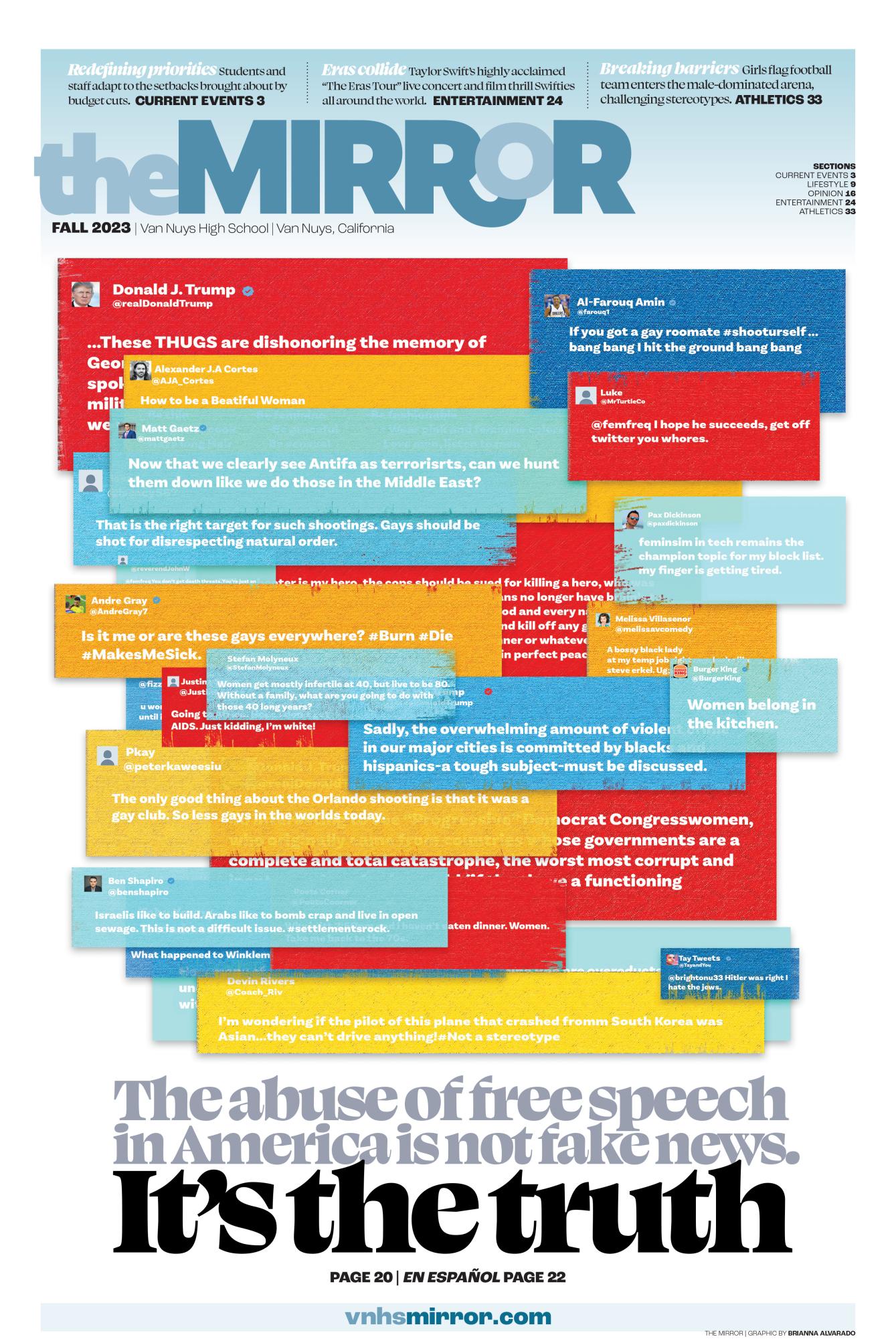As the bell rings for lunch, you rush to the nearest restroom and as you arrive, a line of people are waiting for an available stall. Impatiently, you notice that the stalls are occupied by people unwilling to budge, people who seem to be hiding from school staff.
Vapor floats out of the vacant stalls, filling everyone’s lungs with toxins and leaving a lingering sweet odor in the air.
This is an ordeal students at school are faced with on a daily basis.
Senior Tieara Johnson explains that seeing students vaping in school is a daily occurrence.
“I see it every day, usually in the bathrooms,” she said. “Vapers are just all around the campus.”
Advertised to the international market in 2007 as an aid to reduce smoking, an electric cigarette, or e-cigarette, is a battery-operated device that simulates smoking by producing an aerosol, similar to water vapor and commonly consists of nicotine, cannabis/tetrahydrocannabinol (THC), flavorings or other chemicals from a full cartridge or tank. Users inhale vapor rather than smoke, giving rise to the term “vaping” and the use of an e-cigarette as a vape.
E-cigarettes come in multiple forms, such as a USB flash drive, pen or “box mod,” which is a rechargeable vaporizer in the shape of a rectangle or square that can be modified by the user to alter the vapor or taste emitted by this device.
According to UNDO, a program launched by the California Department of Health, 26.1 percent of high school students reported Puff Bar as their standard e-cigarette brand in 2021.
A 2019 survey conducted by Truth Initiative, a nonprofit health organization, found that 81 percent of adolescents ranging from 12 to17 years old reported flavored merchandise as the first tobacco products they tried.
Furthermore, Truth Initiative found that the most popular flavors among high school students are fruit, mint, menthol and candy.
Since 2014, the use of e-cigarettes has rapidly increased to the point where it is now the most popular tobacco product among adolescents and the second most popular product in the country.
The rapid increase in juvenile e-cigarette use in 2018 led the Federal Drug Administration (FDA) to label the use of e-cigarettes among youth as an epidemic with no signs of waning.
According to the Truth Initiative, from 2017 to 2019 there were sharp increases in the number of high school students who reported vaping in the 30-day increments of the survey, increasing from 11.7 percent in 2017 to 21 percent in the year that followed and escalating to 27.5 percent in 2019, until the percentage decreased in 2022 to 14.1 percent.
The 2022 Annual National Youth Tobacco Survey found that 2.12 million high school and 380,000 middle school students report ongoing use of e-cigarettes.
The rise of e-cigarette use in adolescents is attributed to tobacco companies that target teenagers through marketing strategies such as broadcasting their products on social media platforms and mobile apps, as well as displaying their products as being similar to food items.
By 2019, 69.3 percent of middle and high school students reported encountering some form of tobacco advertisement that endorsed the use of vapes on the internet, in convenience stores, in magazines and on television.
Under the Centers for Disease Control and Prevention (CDC), factors associated with adolescent tobacco include but are not limited to advertisements in mass media that encourage and normalize the use of tobacco, the variety of flavors and designs that appear enticing to youths, the existing use of tobacco products within families and the lack of education and support.
National, state and local initiatives such as raising costs for tobacco products, forbidding the use of e-cigarettes in public spaces and community programs that encourage tobacco-free lifestyles aim to reduce the use of tobacco among juveniles.
In 2019, LAUSD filed a class-action lawsuit against Juul Labs claiming that the e-cigarette manufacturer endangered and obstructed the learning of over 600,000 students in the district.
The district argued that funds allocated towards classroom instruction were being diverted into the treatment and prevention of student vaping across campuses. This harmed school property by rendering student bathrooms inaccessible due to the high volume of vaping in the bathrooms.
The outcome of this lawsuit has not yet been determined. However, in September of 2022, Juul Labs agreed to settle and pay an approximate total of $440 million to 33 states that claimed the company promoted the use of nicotine while failing to warn consumers that its products were more addictive than cigarettes and advertised its vapes in a manner that would attract minors.
E-cigarettes and vapes on middle and high school campuses have reached schools across L.A.County and remain pervasive.
Stephany Hernandez, an eighth-grade student at Richard E. Byrd Middle School, recounts how often she comes across students vaping in the bathrooms and how she believes it is a big problem at her school.
“It’s everyday or every other day,” she says. “I think it’s a really big problem because students go to the restroom and they have to come across horrible smelling vapor in the air that negatively affects their lungs.”
Hernandez critiques how her school manages the discipline given to students caught vaping on campus.
“The administrators have told us that they have a list of people and recognize certain individuals smoking but don’t question them about it,” she states. “They just send them to detention and call it a day.”
Adolescent use of e-cigarettes or vapes puts users at risk of irreversible brain damage from nicotine exposure, as this may affect learning and concentration skills. It also puts users at an increased risk for long-term health issues such as mood disorders, cardiovascular disease, lung disease, seizures and more.
Regular cigarettes contain approximately 600 ingredients and emit more than 7,000 toxic chemicals, with at least 69 chemicals known to cause cancer. In contrast, e-cigarettes contain volatile organic compounds (VOCs), heavy metals such as tin, nickel and lead and a chemical linked to lung cancer called diacetyl.
Although vaping exposes an individual to fewer toxic chemicals than traditional cigarettes, outbreaks of e-cigarette or vape use-associated lung injury (EVALI) and vaping-induced sudden cardiac arrest (SCA) suggest otherwise.
Despite some e-cigarettes helping adults transition from standard cigarettes to e-cigarettes, it’s important to note that no e-cigarette product has been approved by the FDA as a device that discontinues smoking.
While further research is required to determine the long-term effectiveness and safety of e-cigarettes, no tobacco products are safe.
When a student is first spotted vaping, a dean or an administrator is notified. From there, a discipline referral is made to My Integrated Student Information System (MISIS), where the vape or e-cigarette is confiscated and a parent is contacted.
Depending on what the vape consists of and whether or not a student has an addiction, they are either referred to the school’s Tobacco Use Prevention Education (TUPE) program or an outside drug rehabilitation and support center, such as the Tarzana Treatment Center.
Assistant Principal Mr. Martin Tate assigns first-time offenders a five-paragraph essay where they research the effects e-cigarettes pose on juveniles.
If a student is repeatedly caught vaping on campus or in possession of a vape with THC or marijuana, the school police are notified and the student is issued a citation where they have to go to court. From there, the court assigns the student to a diversion program, such as drug treatment or community service, to prevent them from drug use.
State-wide measures, such as Proposition 31, have been upheld by California residents in 2022 to maintain Senate Bill 793, which prohibits the sale of flavored e-cigarettes in the state. In doing so, the bill intends to reduce the use of tobacco products among adolescents, considering flavored vapes are the most popular among youths.
Since the implementation of the bill, Assistant Principal Tate believes that there hasn’t been a decrease in adolescent vaping on school campuses because of how accessible it is for a student to obtain a vape.
“Whether a student buys it on the street or their parents and family members vape, e-cigarettes are too accessible to students,” he said.
To mitigate the frequency of vaping on campus, particularly in the restrooms, adult supervisors are assigned to oversee the inside and outside of a restroom reflective of their gender.
Mr. Tate describes the initiative as a challenge to guarantee safety while maintaining privacy.
Supervision Aid Mr. Luis Cornejo notes how the use of e-cigarettes in students is out of hand on campus.
“It’s uncontrollable,” he said. “We try to do as much as possible but since we don’t have an adult specifically for this issue, it’s kind of hard to deal with.”
The school’s psychiatric social workers Ms. Karina Lares and Ms. Katherine Stockly are available to students Monday through Friday from 8:30 a.m. until 4 p.m. in room 114A to support students with any psychological or emotional inquiries they might have.
Restorative Justice advisor Mr. Donald Cloutier and Educare Coordinator Ms. Natalie Bernal hold restorative justice circles in room 513 and supervise TUPE.
Led by District Facilitator Mr. Daniel Umanzor, TUPE sessions are held weekly on Thursdays afterschool to educate students about the dangers of drug usage. Students collaborate with staff to create and lead campaign events every month to advocate healthy lifestyles and spread awareness.
Students referred to TUPE by administrators have to complete a fixed amount of hours. After their first violation, students referred to the program by Mr. Cloutier have to complete three sessions that equate to three service hours. From there, the amount of hours double for each repeated offense and parents are involved.
Mr. Umanzor expresses that TUPE has been effective for students that seek the help and are willing to put in the effort to change.
Despite a limited spending budget of $30 per month, Mr. Umanzor hopes to overcome the negative narrative against Tobacco-Free programs by cultivating students that are passionate about the program as well as leaders and advocates in their communities.
“I’ve seen a lot of kids come to meetings with their friends or peers that would go out of their way to speak with other students at events,” he said. “They’re really what’s going to change the stigma against Anti-Tobacco programs.”
For further services and information about quitting vaping, contact the Substance Abuse and Mental Health Service Administration at www.samhsa.gov or call 1-800-662-4357.
The abridged version of this article appeared in the Fall 2023 print edition. This is an uncut version.




